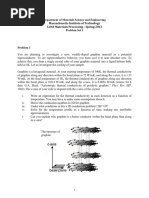Problem Set 6
Uploaded by
roland.m.tranProblem Set 6
Uploaded by
roland.m.tranPhysics 347 Problem Set 6 due: Dec.
6 page 1
26. Red-cell lysis pressure.
At issue in this problem is the degree of osmotic imbalance allowed by the red-cell membrane.
If the red cell is exposed to a hypotonic environment (one with a lower concentration of
osmolites than occurs inside the cell), water will flow into the cell until it swells to spherical and,
if the osmotic imbalance is large enough, lyses (ruptures) and then reseals due to the line tension.
What is the largest osmotic imbalance in moles/litre which the red cell can withstand without
rupture?
Data:
Stretch modulus K s = 0.16 J /m 2 ; lysis occurs at 2% area expansion.
Red-cell membrane area=140 µm2
Hint: See Tutorial 8.1 and Lecture 20.1.
!
27. Membrane closure due to edge tension.
Consider a flat circular patch of membrane of radius R. Assume that the membrane material is
symmetrical, so the membrane is flat in its relaxed state and has a bending energy given by
2
"b #1 1&
Eb = ) dA% + ( . This patch is surrounded by an open edge which
2 S $ R1 R1 '
has an energy E edge = 2"R# , where λ is the edge energy/unit length. In r θ
this problem, you will explore the conditions under which the edge tension
!
is sufficient to force the patch to close up into a sphere.
To make the problem tractable, assume that the patch always has the shape
of a!spherical cap, as shown at the right, so that the open edge remains
circular with radius " = r sin # .
(a) Show that the area of the cap is related to r and θ by A = "R 2 = 2"r 2 (1# cos $ ) . Since A is
fixed, this is a relation between r and θ.
(b) Show ! that the energy of the patch (including both the edge energy and the bending energy)
$ $
can be written as E = 8"#b sin 2 + 2"R% cos !.
2 2
8"
(c) Show that there is a critical patch size Rc = b such that the patch will close to a sphere for
#
R>Rc. What happens for R<Rc? Estimate the value of Rc. ( " b ~ 25 kB T; # = 30 k B T /nm )
!
28. Principal radii of curvature in the Monge representation.
! that, when the height function z(x,y) has the form
(a) I told you in class (Lect. 32.2)
1 2 1 2 !
z= x + y , then Rx and Ry are the radii of curvature of the surface in the xz and yz
2R x 2R y
planes. Prove that this is true. These are by definition the principle radii of curvature R1,2 at the
point x=y=0.
a c
! (b) Consider a surface described in the Monge representation by z( x, y ) = x 2 + bxy + y 2 .
2 2
What are the principal radii of curvature of this surface at the point x=y=0.
29. Long charged cylinder with counterions (Manning condensation)
In this problem, you will solve (exactly!) the problem of!a line charge (like DNA) in aqueous
solution.
Consider an infinitely long thin cylinder of radius a with a (negative) symmetrically
distributed surface charge –λ per unit length immersed in water solution. A density page 2
n ( r) of corresponding positive neutralizing charges q has been released into solution. The a
problem is to use the Poisson-Boltzmann equation to calculate the equilibrium charge
distribution,
q$
#
! k BT
"( r) = qn ( r) = qn 0e . (see Lect. 29.1—29.3 for 1D analog).
(a) Use Gauss’s theorem to calculate the electric field E ( r) for r " a in terms of λ and ρ(r).
# 1
! (b) From (a), show that the electric field at r=a is E ( a) = " & .
2$% a
This will be come a boundary condition in what follows.) !
! d#
(c) Again, starting from (a) and using the fact that E ( r) = " , show that the electric potential
dr
1 d # d" & * ( r) !
satisfies %r (=) . This is just the Poisson equation with cylindrical symmetry.
r dr $ dr ' +
With the substitution of the expression for!ρ(r) given above, it becomes the Poisson-Boltzmann
equation.
r q$
!(d) Show that, by making the substitutions u " ln and " ( r) # % 2u , the Poisson-
a kBT
d 2"
n 0q 2 a 2 #"
Boltzmann equation can be written = # e . This equation now has the 1D form.
du 2 $k B T
! 29) to find
(e) Integrate this equation (as in Lect. ! the solution,
$ '
q" r n q2a2 r )
= 2ln + 2ln&1+ 0 ln , where I have used the boundary condition that "( a) = 0 .
kB T a & 2!
#k B T a )(
%
Be careful about signs.
(f) It remains to apply the boundary condition from (b) to determine the normalization constant
n0 for the density distribution. Do this—carefully! Show that there is a consistent! solution with
! 2
q
n 0 > 0 if and only if " > q /l B , where l B " is called the Bjerrum length (PKT p. 340).
4 #$kB T
Find this solution.
Comment: The only solution for " # q /l B is n0=0. The meaning of this is that, for charge
! densities λ !below this critical density, none of the counterions remain bound near the line charge.
Instead, they have all wandered ! off to infinite distances. This is an entropic effect due to the
infinite volume; it is analoguous to what happens to an atomic or molecular bound state in
infinite volume (it always! ionizes at any T>0).
(g) For the λ above the critical density calculate the overall density of bound screening charge,
"
Qscreening = # ( dr)$ ( r) .
a
q
Note: You will find that Qscreening = " # , which has the interpretation that, above the
lB
critical line density of charge, there is sufficient screening so that, looked at from a very long
!
distance, the line charge and its screening cloud always has an unscreened charge per unit length
of q /l B . This is sometimes referred to as “charge renormalisation.” You will recall that, in 1D,
! screened. In 3D, all the charge escapes to infinite. This peculiar behavior is
all the charge was
specific to 2D and is called Manning condensation.
!
You might also like
- IIT-JEE 2004 Mains Questions & Solutions - Physics - Version 2No ratings yetIIT-JEE 2004 Mains Questions & Solutions - Physics - Version 212 pages
- A. Using Eq. (2) Derive The Density of States of The Conducton Band Only To First-Order in The Parameter B. Also To First-Order in SolutionNo ratings yetA. Using Eq. (2) Derive The Density of States of The Conducton Band Only To First-Order in The Parameter B. Also To First-Order in Solution10 pages
- PH4211 Statistical Mechanics: Problem Sheet 1No ratings yetPH4211 Statistical Mechanics: Problem Sheet 1129 pages
- ² - ∇Φ - d x = (by Green I) −² x + ² ∂ ∂n V ∂ ∂n V σda = V σda = V QNo ratings yet² - ∇Φ - d x = (by Green I) −² x + ² ∂ ∂n V ∂ ∂n V σda = V σda = V Q9 pages
- 03.0 Laplace and Poissons Worked SolutionsNo ratings yet03.0 Laplace and Poissons Worked Solutions9 pages
- Errata For Conquering The Physics GRE, Edition 2No ratings yetErrata For Conquering The Physics GRE, Edition 29 pages
- Physics 210A Homework #4 Solutions: Problem 1. Jackson 2.23No ratings yetPhysics 210A Homework #4 Solutions: Problem 1. Jackson 2.237 pages
- Lecture Notes On Legendre Polynomials: Their Origin and Main PropertiesNo ratings yetLecture Notes On Legendre Polynomials: Their Origin and Main Properties18 pages
- Poisson and Laplace's Equations: Free Charge!No ratings yetPoisson and Laplace's Equations: Free Charge!7 pages
- PH4211 Statistical Mechanics: Problem Sheet 2 - AnswersNo ratings yetPH4211 Statistical Mechanics: Problem Sheet 2 - Answers14 pages
- International Centre For Theoretical Physics: International Atomic Energy AgencyNo ratings yetInternational Centre For Theoretical Physics: International Atomic Energy Agency8 pages
- Solutions For Problems in A Short Introduction To Mathematical Concepts in Physics by Napolitano100% (1)Solutions For Problems in A Short Introduction To Mathematical Concepts in Physics by Napolitano8 pages
- Problems in Quantum Mechanics: Third EditionFrom EverandProblems in Quantum Mechanics: Third EditionD. ter Haar3/5 (2)
- Zoology 10th Edition Miller Test Bank - Read Online Or Download Now100% (2)Zoology 10th Edition Miller Test Bank - Read Online Or Download Now54 pages
- Cell Membranes & Movement Across Them: Regents BiologyNo ratings yetCell Membranes & Movement Across Them: Regents Biology26 pages
- Difference Between Osmosis and DiffusionNo ratings yetDifference Between Osmosis and Diffusion9 pages
- Komar University of Science and Technology Practical General Molecular Biology Lab Section (L-3)No ratings yetKomar University of Science and Technology Practical General Molecular Biology Lab Section (L-3)5 pages
- Cell Transport Review Worksheet: A. B. C. DNo ratings yetCell Transport Review Worksheet: A. B. C. D2 pages
- Lab Report On The Effect of Osmosis On Potato Tissue33% (3)Lab Report On The Effect of Osmosis On Potato Tissue4 pages
- AQA As Required Practicals Methods Questions and Mark SchemesNo ratings yetAQA As Required Practicals Methods Questions and Mark Schemes29 pages
- Chapter 3 Movement of Substances Across Cell Membrane - AnsNo ratings yetChapter 3 Movement of Substances Across Cell Membrane - Ans2 pages
- Controlled Release Oral Drug Delivery SystemNo ratings yetControlled Release Oral Drug Delivery System110 pages
- Class 10 - MTG - Rephrased - Life ProcessesNo ratings yetClass 10 - MTG - Rephrased - Life Processes24 pages
- 5 - Osmosis and Diffusion Report Form Ed 6.1No ratings yet5 - Osmosis and Diffusion Report Form Ed 6.16 pages
- [Cô Vũ Mai Phương] Đề Thi Thử THPT 2025_THPT Chuyên Phan Bội Châu - THPT Chuyên Hà TĩnhNo ratings yet[Cô Vũ Mai Phương] Đề Thi Thử THPT 2025_THPT Chuyên Phan Bội Châu - THPT Chuyên Hà Tĩnh7 pages

























































































